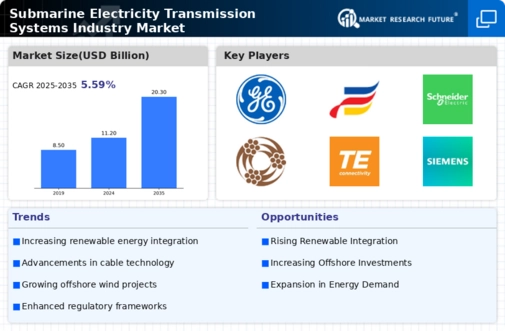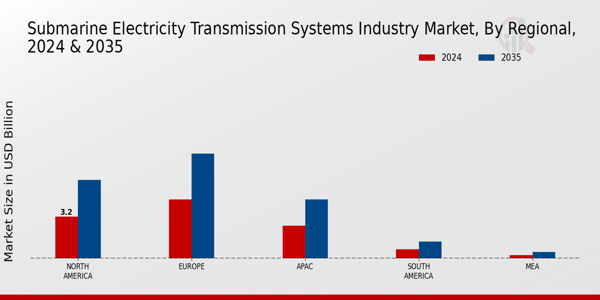Market Growth Projections
The Global Submarine Electricity Transmission Systems Industry Market is poised for substantial growth, with projections indicating a market size of 11.2 USD Billion in 2024 and an anticipated increase to 20.3 USD Billion by 2035. This growth trajectory suggests a robust CAGR of 5.59% from 2025 to 2035. The increasing demand for renewable energy integration, technological advancements, and government investments are key factors contributing to this positive outlook. As the industry evolves, it is likely to adapt to emerging challenges and opportunities, ensuring its relevance in the global energy landscape.
Rising Energy Consumption
Rising global energy consumption is a significant driver for the Global Submarine Electricity Transmission Systems Industry Market. As economies expand and populations grow, the demand for electricity continues to escalate. This trend necessitates the development of efficient transmission systems to ensure reliable energy delivery. Submarine electricity transmission systems play a crucial role in connecting remote energy sources to urban demand centers. The market is expected to reach 20.3 USD Billion by 2035, reflecting the urgent need for infrastructure that can support increasing energy demands. This growth highlights the critical role of submarine systems in meeting future energy needs.
Growing Demand for Renewable Energy
The Global Submarine Electricity Transmission Systems Industry Market is experiencing a surge in demand driven by the increasing reliance on renewable energy sources. As countries strive to meet their climate goals, offshore wind farms and solar energy installations are becoming more prevalent. This trend necessitates robust submarine electricity transmission systems to connect these renewable sources to the grid. The market is projected to reach 11.2 USD Billion in 2024, reflecting the urgency for efficient energy transmission solutions. The integration of renewable energy into existing infrastructures is likely to further propel the growth of this industry.
Government Initiatives and Investments
Government initiatives aimed at enhancing energy infrastructure are pivotal in shaping the Global Submarine Electricity Transmission Systems Industry Market. Various nations are investing heavily in submarine electricity transmission projects to bolster energy security and promote sustainable practices. For instance, the European Union has launched several initiatives to develop interconnections between member states, facilitating the integration of renewable energy sources. Such investments not only enhance grid reliability but also stimulate economic growth in the sector. The anticipated market growth to 11.2 USD Billion in 2024 reflects the positive impact of these governmental policies.
Technological Advancements in Cable Systems
Technological innovations in submarine cable systems are significantly influencing the Global Submarine Electricity Transmission Systems Industry Market. Enhanced cable designs, such as high-voltage direct current (HVDC) technology, offer improved efficiency and reduced energy losses during transmission. These advancements enable longer distances for electricity transfer, making it feasible to connect remote renewable energy sources to urban centers. As a result, the market is expected to grow at a CAGR of 5.59% from 2025 to 2035, reaching an estimated 20.3 USD Billion by 2035. This growth underscores the importance of continuous innovation in maintaining competitive advantages.
Increasing Interconnectivity Between Regions
The Global Submarine Electricity Transmission Systems Industry Market is also driven by the increasing interconnectivity between regions. As countries seek to enhance energy security and diversify their energy sources, submarine cables serve as vital links for electricity exchange. This interconnectivity allows for the sharing of renewable energy resources, thereby optimizing energy distribution. The market's growth trajectory, projected at a CAGR of 5.59% from 2025 to 2035, indicates a strong future demand for these systems. Enhanced regional cooperation and cross-border electricity trading are likely to further support this trend.














